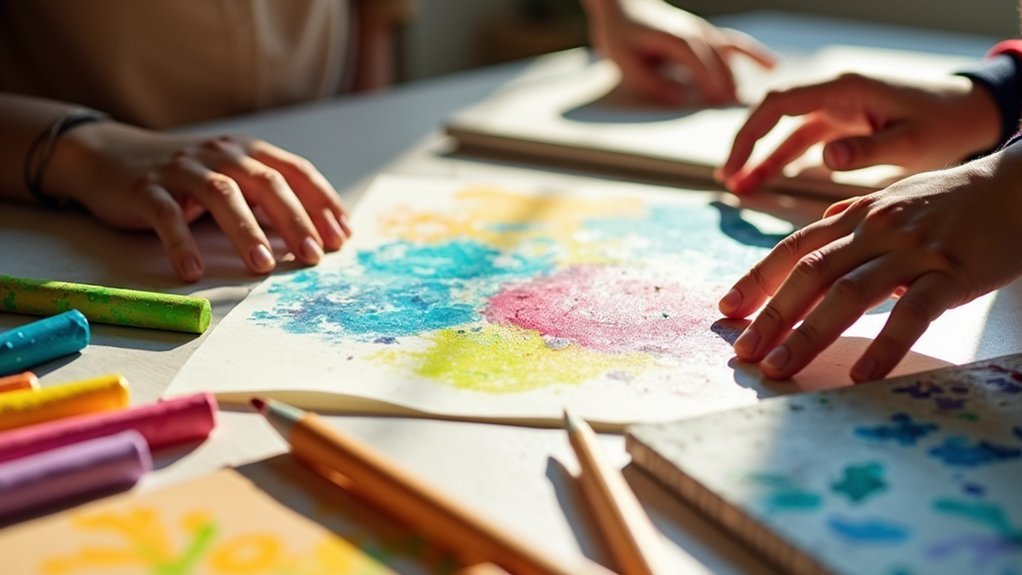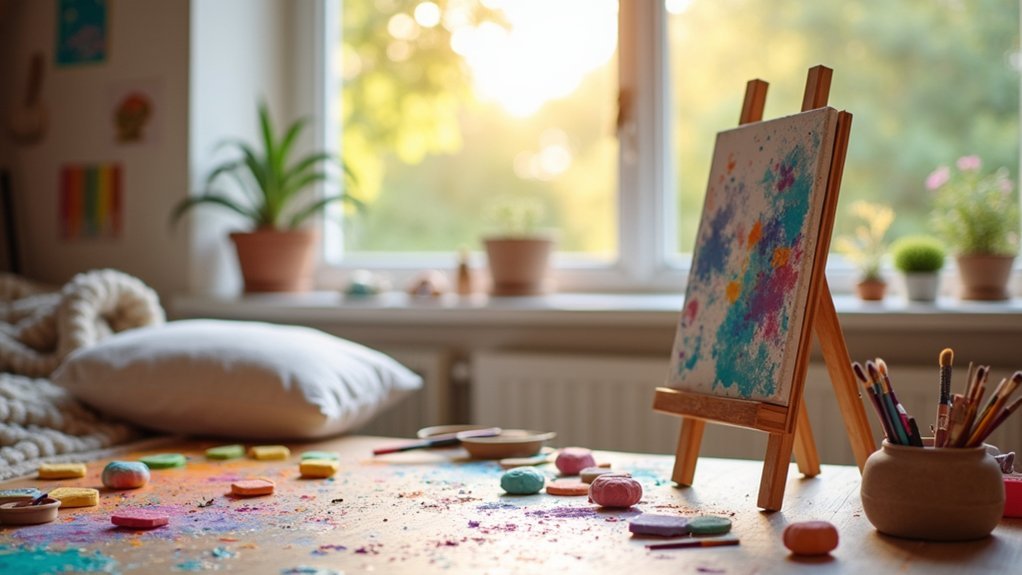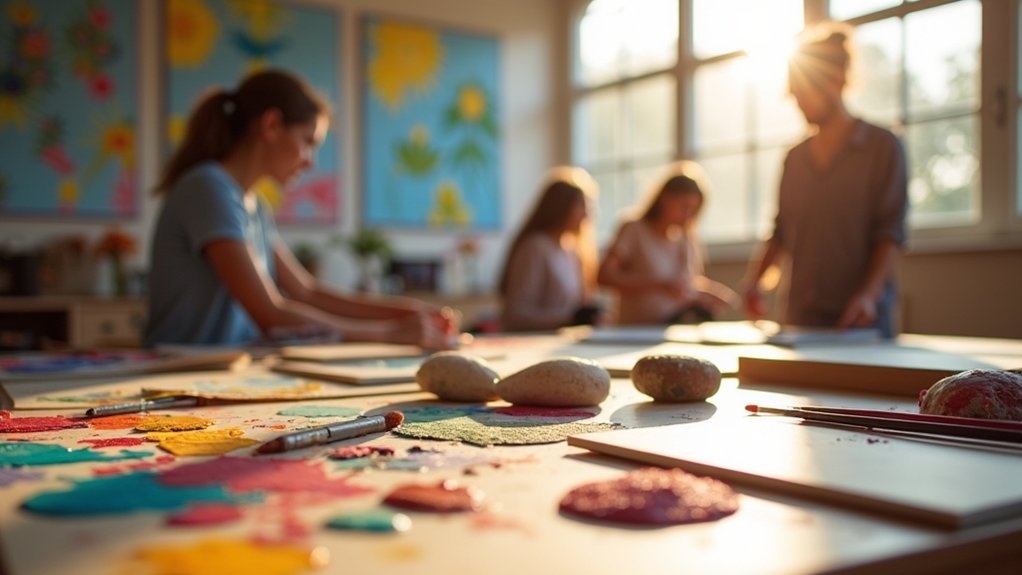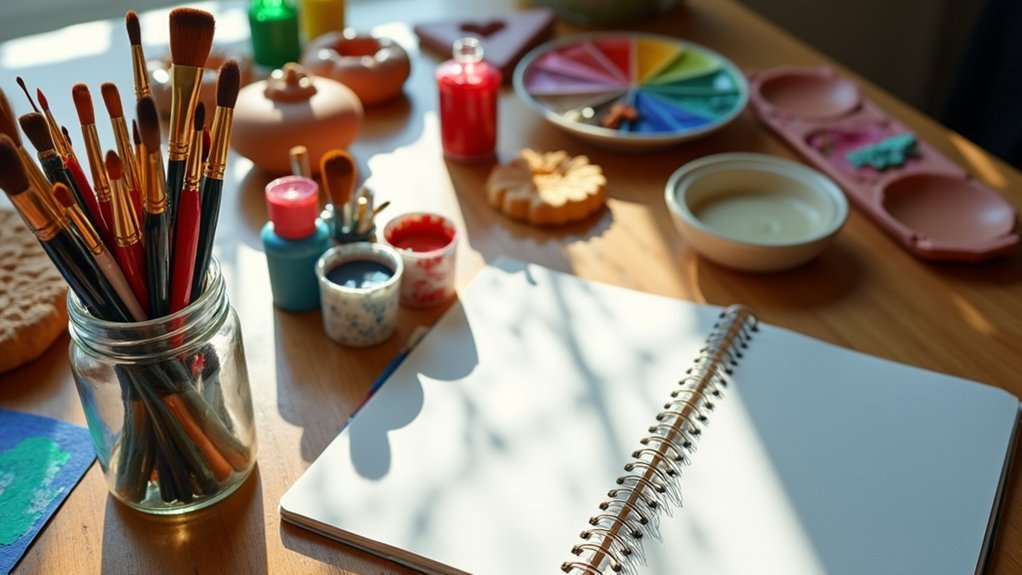Adaptive art therapy tools break physical barriers to mental wellness through specially designed implements like triangular grips, modified scissors, and digital options. You’ll find creative techniques including multisensory approaches and collaborative projects that accommodate your unique needs. These adaptations deliver proven psychological benefits—reducing anxiety and depression while enhancing self-esteem and neuroplasticity. Community art-making further strengthens social connections and emotional well-being. Countless success stories demonstrate how these accessible approaches transform limitations into pathways for profound healing.
Essential Adaptive Art Tools for Limited Motor Function

Five key categories of adaptive art tools have revolutionized creative expression for individuals with limited motor function.
Triangular and jumbo-sized drawing tools offer improved grip and require less precision, making them ideal if you’re struggling with fine motor control.
Customize your creative journey with triangular and jumbo tools designed specifically for artists with motor challenges.
Adapted scissors, including loop and tabletop versions, enable cutting with minimal hand strength.
For traditional tools, ergonomic handles provide essential support and comfort during extended creative sessions.
For those with severe limitations, modified tools that attach to fingers can transform your artistic capabilities.
Digital options like specialized software and tablet-stylus combinations allow for creative expression without physical dexterity requirements. Tools like the Spirograph or Paint Spinner with a Big Red Button create opportunities for inclusive artmaking regardless of movement limitations.
When setting up your creative space, consider adjustable workstations, ideal lighting, and organized storage to maximize comfort and reduce strain during art therapy sessions.
Creative Expression Techniques for Physical Barriers
Beyond having the right tools, mastering specific techniques can dramatically enhance your creative expression when facing physical barriers.
Art therapy integrates creative processes with psychological theory, empowering you through a sense of mastery and achievement regardless of physical limitations.
Consider these adaptable approaches that focus on your abilities rather than limitations:
- Art journaling can be modified to your specific needs, offering a reflective outlet that builds fine motor skills while processing emotions.
- Multisensory techniques incorporate touch, sound, and texture to create rich artistic experiences when visual perception is limited.
- Experiential activities like collaborative murals allow you to contribute meaningfully within your physical capacity.
- Therapist-guided sessions provide structured support while encouraging your unique creative voice.
Engaging with various art forms like painting, drawing, and sculpture provides non-verbal outlets for those who struggle with traditional communication methods.
The Psychological Benefits of Modified Art Therapy

While conventional therapies often require verbal expression, modified art therapy reveals profound psychological benefits through non-verbal creative channels.
When you engage in these adapted creative activities, you’re actually enhancing your brain’s neuroplasticity and boosting dopamine production—directly improving your mood and emotional resilience.
Studies consistently show that modified art therapy markedly reduces anxiety, depression, and trauma symptoms while improving cognitive function.
Modified art therapy significantly reduces psychological distress while enhancing cognitive abilities—a powerful tool for holistic mental wellness.
You’ll experience better emotional regulation as you process complex feelings through creative expression rather than words. This approach is particularly effective for those facing communication barriers.
The therapeutic benefits extend beyond symptom reduction to include improved self-esteem, stress management, and interpersonal skills.
Your brain literally rewires itself during creative engagement, creating new neural pathways that support healing and psychological wellbeing.
Modified art therapy provides a breakthrough for substance abuse treatment by giving patients a non-verbal approach to explore underlying emotional issues that contribute to addiction.
Building Community Through Accessible Art Making
The benefits of modified art therapy extend naturally from individual healing to collective transformation through community-based creative experiences.
When you participate in community art initiatives, you’re not just creating—you’re building social connections and fostering a sense of belonging in your neighborhood.
Public art projects like MuralsDC demonstrate how creative expression can revitalize communities, especially in historically marginalized areas.
Today’s inclusive approaches emphasize:
- Technology integration that makes art accessible for people with disabilities
- Local artist involvement to guarantee authentic cultural representation
- Diverse sensory experiences beyond visual art for blind and low-vision participants
- Equitable funding strategies that support community-led initiatives
These community-centered approaches transform public spaces while reducing stress, combating loneliness, and empowering individuals through collective creativity. Research shows that public art participation contributes significantly to mental health benefits, with 84% of London survey respondents reporting improved well-being from engagement with public art.
Case Studies: Success Stories in Adaptive Art Interventions

Evidence from real-world applications reveals how adaptive art therapy has transformed lives across diverse populations struggling with mental health challenges. Through personalized approaches, you’ll find remarkable improvements in emotional expression, anxiety management, and trauma processing. For individuals like Simon, art therapy provides a valuable non-verbal method to explore emotional pain when traditional talk therapy proves ineffective.
| Condition | Intervention | Observed Outcomes |
|---|---|---|
| Depression | Painting & Collage | Improved emotional expression, increased self-esteem |
| Anxiety | Anthroposophic techniques | Enhanced emotion regulation, better executive functioning |
| Trauma | Progressive art creation | Journey from chaotic to serene compositions |
| Social Challenges | Community art-making | Strengthened social networks, improved interaction |
| Emotional Regulation | Guided visualization | Better understanding of internal emotional states |
These case studies demonstrate how non-verbal creative outlets provide therapeutic pathways when traditional approaches may be insufficient, especially for those with complex mental health needs or communication difficulties.
Frequently Asked Questions
How Are Art Therapists Trained to Work With Physically Disabled Clients?
You’re trained in adapting art materials, modifying techniques for mobility limitations, understanding psychological impacts of disability, learning assistive technologies, ensuring accessible spaces, and collaborating with healthcare teams through specialized coursework and supervised clinical practice.
What Insurance Coverage Is Typically Available for Adaptive Art Therapy?
Insurance coverage for adaptive art therapy typically depends on your provider having proper licensure. You’ll find better coverage when it’s prescribed as medically necessary and delivered by fully-licensed practitioners with recognized mental health credentials.
Can Art Therapy Be Effective Without Verbal Communication Skills?
Yes, art therapy’s highly effective without verbal skills. You’ll express yourself through colors, shapes, and symbolism instead. It’s actually ideal for non-verbal clients, offering emotional release and communication beyond words.
How Do Cultural Backgrounds Influence Adaptive Art Therapy Approaches?
Cultural backgrounds shape how you’ll experience art therapy. You’ll need culturally relevant materials, symbols, and practices that respect your heritage. These adaptations enhance your engagement, build trust, and create meaningful therapeutic connections.
What Technological Innovations Are Emerging in Accessible Art Therapy Tools?
You’ll find AI-enhanced emotional analysis, digital platforms with customizable tools, AR/VR immersive environments, and telehealth integration revolutionizing art therapy. These innovations break geographical barriers and personalize therapeutic experiences for your unique needs.
In Summary
Art therapy transcends physical limitations when you’re equipped with the right adaptive tools. You’ll discover that creativity doesn’t depend on full mobility, but rather on having accessible options that honor your unique abilities. As you’ve seen through countless success stories, your artistic journey can foster healing, connection, and self-discovery regardless of physical barriers. Your expression matters—and now you’ve got the tools to make it happen.





Leave a Reply